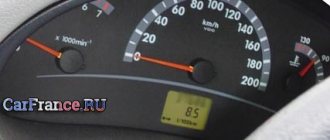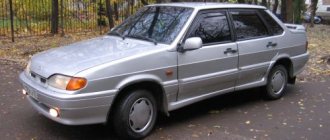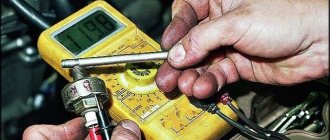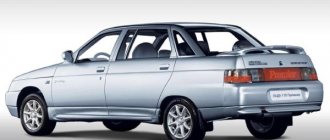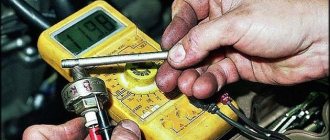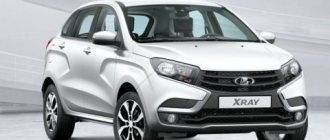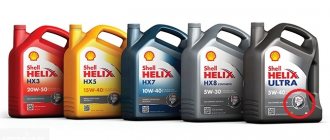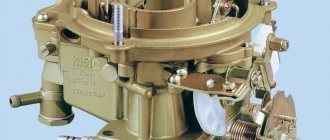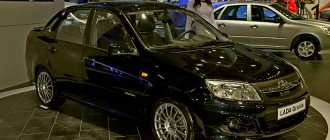Absolutely all Lada Kalina owners are interested in such an indicator as the fuel consumption of their car, and surely each of us wants to make it less. But there are many owners who even dream of factory performance.
The video above shows that the instantaneous consumption of my 8-valve Kalina at a speed of 100 km/h is no more than 5.8 liters, provided that the car has winter tires and the car is almost fully loaded. There is no catch there, AI-92 gasoline, I’m driving on a flat but very good road, I think that with summer tires the numbers would be even lower.
So, over my entire driving experience of 8 years and the total mileage on all my cars is at least 300,000 km, I have several comments and opinions about what can affect fuel consumption and how to moderate the engine’s appetite. This is my personal opinion and I do not impose it on anyone and do not insist that this is 100% true, but judging by my experience, everything was exactly like that.
About the real fuel consumption of Lada Kalina
The fuel consumption indicated by the manufacturer may differ significantly from the readings observed by the owners of this car. Let's find out what gasoline consumption of the Lada Kalina is indicated in the instruction manual and what real figures are observed by car enthusiasts.
The technical characteristics of Kalina (sedan, station wagon, hatchback or sport) indicate “Fuel consumption by driving cycle, l/100 km”:
- for Kalina 1.4l is equal to 7.0;
- for Kalina 1.6l from 7.2 to 7.8.
To determine the real fuel consumption on Kalina 1.4, we analyzed reviews from owners. As a result, it turned out that:
- Consumption in the city ranges from 6.8 l/100 km to 11.5 l/100 km. The average is 8.47 l/100 km.
- Highway consumption ranges from 5l/100km to 8.5l/100km. The average is 6.18 l/100 km.
- The combined cycle ranges from 6.5l/100km to 8.3l/100km. The average is 7.29 l/100 km.
Fuel consumption for Kalina 1.6 will be slightly higher, the average is 9/6.8/8 for city/highway/mixed. Why do some people have high fuel consumption in their Lada Kalina, while others have much less? There may be several reasons, here are the main ones:
- Driving style. The differences in fuel consumption during quiet driving and active driving (with sharp braking and acceleration) can be significant (10-25%).
- Gasoline quality. Gasoline consumption of AI 95 will be less than AI 92 (article).
- Seasonality. Kalina's consumption per 100 km. in winter it will be more due to slippery roads and warming up. The difference with summer will be 1-2 liters.
- Traffic jams. Even a small traffic jam can increase gasoline consumption by 2 liters.
- Air conditioner. When the air conditioner is turned on, Kalina's consumption increases by 0.5-1 liters.
- Malfunctions of Kalina. If fuel consumption on Kalina has increased significantly, then you should diagnose the car and determine the reasons for the high gasoline consumption.
Hello! I would like to seek advice and help. I have a Kalina 11193 1.6v 8 valves, mileage: 36,000 km, Itelma M74 ECU. The car shakes a lot when I’m standing at an intersection, the revs range from 500-1000, it smells of gasoline, there’s a slight black smoke, increased fuel consumption, the spark plugs are black, i.e. (Rich mixture). Errors during scanning are current (p0171 fuel supply system is too lean, p2187 fuel supply system at XX is too lean) sometimes errors do not always appear (p0130 Oxygen sensor before the converter is faulty and p0131 Oxygen sensor before the converter, low output signal level) Sensors DC 1 and DC 2 were changed recently. There are misfires, I checked the system for air leaks, no leaks were detected. I have scanned it twice already with the same errors mentioned above (POOR MIXTURE), but the cause has not yet been found. Changed the DTOZH sensor. because The car warms up not to 90, but to 87 degrees while driving, replacing the sensor did not help. For some reason, the DC sensors do not always work adequately; they show 0, and after accelerating they come to life. Maybe this is due to an existing problem. Maybe someone has already encountered something similar and knows a solution to the problem? Thank you!
It’s an old question, but I’ll answer. The problem seems to be in the valve that is not on the air. It's called the absorber valve. jammed.
Added after 9 minutes 25 seconds:
Re: Increased fuel consumption. Kalina. Need advice.
Kalina 1.6 8kl, mileage 20 thousand. Consumption 13-16 l. around town. The valves were adjusted at TO1 when it was under warranty. Diagnostics on the VAZ program does not show any errors. E-gas costs. The spark plugs are ideal. The tachometer needle moves a little (a few mm) at idle. There are no failures. Pickup is normal. Sometimes the transmission generated error P0504. But she appears very rarely. I don’t know what else, where to look, to look.
The problem with Kalina with e-gas is increased consumption in transitional modes “city driving” from 11 liters I myself am interested in this problem in the process over the course of several years I have already become a car diagnostician myself One thing I can say when they say that this problem is that the engine is faulty or that you push too much on gas or a new one has not been run in, then these crap. The problem of high consumption on e-gas Kalinas is precisely a problem inherent in the design! and the reason has not yet been clarified. Exactly the same engines on a cable spend 1.5-3 liters less on the same roads and with the same dynamics.
High consumption, no dynamics, Kalina 8 valves stalls
I changed the viburnum 16 valves to the viburnum 8 valves. This viburnum covered 74,000 km in total in 2010 and was stored in the garage every winter. In general, the car is in good condition. However, she has one very unpleasant problem that I just can’t solve! First, I will describe the essence of the problem, and only then what was done and, as you already understand, none of this helped. Signs
: —
stalls at first start
, when cold, it starts right away and immediately stalls.
- on the second start, if you immediately start moving, it seems to be choking, about to stall
, but there is a nuance, if you press the gas pedal a little bit, then as a result we will go, but if you drown it in the floor, then it will seem it's choking, as if the fuel isn't burning, or there's not enough air, you can't tell.
— okay, let's go, the dynamics are weak while driving
, well, as I understand it, it’s very simple.
Flat road, 3rd gear, 40 km/h - I press the gas to the floor, we can barely move, acceleration is extremely difficult. This has never happened before. — increased fuel consumption
— well, that’s quite sad.
I drove around now and yesterday I drove around the city, I understand that I haven’t driven much, but the average consumption is 15.4. Before that, for two months I drove both on the highway and around the city, but the consumption did not drop below 13. Guys, this is a lot, honestly. — check engine
— the check light comes on, of course, and shows
misfires in different cylinders
.
Cool, what to say. — it feels like the engine is not running smoothly
, it’s probably just the misfires that are felt, it’s constantly shaking.
This is the error that appears most often.
Old lambda and new.
It seems like he didn’t forget anything, he listed all the signs. And now what has been done
: — The timing belt with the roller and pump was replaced, it was torn.
- pressure measurement in the fuel rail - 3.5 - there are new spark plugs and there are old ones, you can also say new ones, - the ignition coil has been replaced - the injectors have been cleaned - the injector of cylinder 2 did not work - replaced with a new one - the compression in the cylinders is the same, even, how much composes, I won’t say, the master checked it (for free), he said that everything was normal, the same everywhere. - I checked the system for air leaks - everything is sealed, we pumped smoke into the system, there is no smoke coming out anywhere, we even opened the plug where the oil dipstick is, it opened like a bottle of beer - with sound and smoke, but no smoke leaks out anywhere, at all. - checked the mass air flow sensor - voltage 1.004
, not to be confused with 1.04
In the photo it was 1.003, but then it was set to 1.004 and did not change.
— washed the throttle. — replaced the silicone gaskets on the intake (plastic) manifold, between it and the engine and between it and the throttle. — Replaced the following sensors: Throttle position sensor, idle air control, camshaft sensor, crankshaft sensor. - the battery was replaced with a Bosh S4 006 - on the “recommendation” of the master, I replaced one of the two lambdas, the one in the cat. manifold is on top. — the fuel filter is new, the mesh on the pump is new, the fuel pump is new (well, it’s not even a year old yet) — I checked the brushes on the generator — they’re fine, everything is in order.
Driving style and operating conditions
When forming the technical indicators of a specific model, the manufacturer draws data from test results at testing grounds. These conditions differ significantly from the actual situation of subsequent operation. A considerable proportion of owners are prone to driving at high speeds and aggressive driving style. Fuel consumption inevitably increases, and the face of the temperamental driver becomes covered with surprise, turning into despondency. Also, not the best way to save money is to hold back the engine or the so-called “tight” driving.
When fuel consumption is high, this results in excessive loading of the body. This circumstance is especially relevant for owners of Lada Kalina universal modifications. Country driving in low gears will inevitably cause a “jump” in fuel consumption. Let's not ignore traffic jams, in which the owner inevitably loses a valuable fuel resource.
In winter, consumption increases due to the need to warm up the engine for a longer time. Turned on comfort systems (heating, stove, etc.) create the same preconditions for excessive waste of gasoline. Note that in summer gluttony also increases due to a running air conditioner.
Recently, the Lada Kalina has been “honored” of the opportunity to be equipped with an automatic transmission unit. Here, the owner’s leverage over the level of consumption is almost taken away, since the “brain” of the box independently determines the moment of transition to a specific level. Owners of such Kalinas can often be found on online forums, where they, in search of the truth, try to find out: why do their cars “eat” a lot?
Method #9: Using conditioner
An air conditioner, like any other attachment, requires effort to drive it using a belt drive. The consequence of such efforts is a noticeable increase in fuel consumption. Try not to turn on the air conditioner unless absolutely necessary. Sometimes, instead of turning on the air conditioner, it is enough to increase the air flow in the cabin or open two windows diagonally.
Real fuel consumption of Lada Kalina (according to reviews from car owners)
Many car owners of the Lada Kalina passenger car complain that in reality, gasoline consumption indicators differ from those specified by the manufacturer. For comparison, let’s look at another information table prepared by specialists taking into account feedback from Lada Kalina car owners.
Lada Kalina, 1.4 l
When comparing two information tables, it is clear that the real figures are indeed higher than the stated factory fuel consumption standards for the Lada Kalina. What are the reasons for this discrepancy between the figures?
The main reasons for the difference between the gas consumption figures for the Lada Kalina passenger car - real and factory ones
There are several reasons for the discrepancy between the actual gasoline consumption figures of the Lada Kalina and the factory standards. Experienced car enthusiasts identify typical ones among them:
- Type of terrain - driving in the city, on the highway, off-road or mixed type of road (the more complex the type of road, the higher the fuel consumption).
- The driver's driving style is slow driving, fast driving, with sharp acceleration, with sharp braking (the more complex the driving style, the higher the gas consumption).
- The quality of the fuel used - AI-95 gasoline is consumed less than AI-92 gasoline.
- Time of year - in winter, fuel consumption rates will be higher, this is affected by icing of the road surface and frequent warming up of the vehicle itself.
- Traffic jams - due to slow driving and frequent braking, gasoline consumption increases by almost several liters.
- Using additional car devices (for example, air conditioning) – with devices constantly on, gasoline consumption will be 0.5-1 liter more.
In addition to the reasons listed, fuel consumption can be affected by various breakdowns of the vehicle itself:
- incorrect readings of the electronic engine control system due to sensor errors - temperature, mass air flow, oxygen, throttle position;
- abnormal pressure in the fuel system;
- internal combustion engine injector malfunction;
- failure of the catalyst;
- dirty air filter.
To install them, the car owner needs to diagnose the Lada Kalina passenger car. After diagnosing and identifying the causes of malfunctions, the vehicle is repaired.
The ECU on Kalina is filled with antifreeze - what to do?
After the block filled with antifreeze has been removed, its initial inspection should be carried out. For these purposes, it is necessary to remove 4 screws using a star screwdriver. Then you should slowly remove the control board for a visual inspection. The most common failure is the burnout of the ignition coil output switch. In this case, repair will not help.
As a result of such a malfunction, the Lada Kalina starts working on only 2 cylinders, and sometimes refuses to start at all. You can cope with a similar problem in a stationary workshop. There they will remove the damaged element, wash and dry it. The second most common problem is board burnout. It is not difficult to detect such a defect: the characteristic blackening of the board will leave no doubt.
Is it possible to repair the ECU in this case? The answer to this question can only be given by a service center, but experience shows that repairs will not help here. A complete replacement is required. It happens that sometimes the brain circuitry is slightly damaged. If this happens, then the car owner can get off easy. To restore the car to working order, you will need some minor repairs:
- wipe the block with a dry cloth;
- rinse with WD-40 several times and blow it out with a compressor;
- rinse several times in alcohol and blow again with a compressor;
- dry well, otherwise the Lada Kalina will not move;
- drying takes at least 1-2 hours.
Method #2: Choose travel times according to traffic conditions.
Essentially, when stuck in traffic, your car travels the entire distance in first gear. But fuel consumption rises not only due to the fact that your engine is not running properly. You get very high consumption when starting the car from a stop - more energy is spent on this than when moving evenly. Plan your activities according to the traffic situations. Nowadays, everyone can afford to install applications that display traffic congestion. Use this and save not only fuel, but also time. If you have things to do that are not tied to weekdays, then why not save them for one day off? If you can get to work an hour earlier, why not spend time at work instead of stuck in traffic? If you are puzzled by this, you can save a lot of time and fuel by avoiding traffic jams.
Practice time management on the roads!
How to save fuel with a VAZ injector?
As for the injector, here things are much more complicated. The fact is that electronic devices that may not work correctly are responsible for the fuel supply. Therefore, if you notice too much fuel consumption, carry out diagnostics; perhaps one of the sensors is not working correctly. Cleaning the injectors and checking them for leaks also helps a lot. In case of leakage, the nozzle must be replaced.
Another problem with system malfunction is firmware. It makes sense to try reprogramming the controller. In skillful hands, the controller can switch the engine to the most economical operating mode.
Some owner reviews
I checked the system for air leaks, everything is sealed, they pumped smoke into the system, there is no smoke coming out anywhere, they even opened the plug where the oil dipstick is, it opened like a bottle of beer with sound and smoke, but no smoke leaks out anywhere, at all. A special pressure regulator bypass valve creates a constant pressure in the fuel line, due to which the fuel passes through a fuel filter made of special paper and enters the ramp, and then to the injectors and into the engine.
The main reasons for high fuel consumption on the Lada Kalina
There are quite a few reasons, but in this article we will try to consider them all. This is primarily due to improper operation of the vehicle and untimely maintenance. So, what are the reasons for the high fuel consumption of the Lada Kalina:
It's time to change this air filter
Condition of the candles in the photo
The photo shows a not very dirty BDZ, it can be worse
How to diagnose problems
13.3 liters per hundred is a lot even for the economical Kalina, even for driving in traffic jams
Diagnostics of faults should be carried out step by step until the cause of failure of a particular part that affects the increase in consumption is determined:
- Checking the air filter. If there are brown deposits on it, it should be replaced. Scheduled replacement is carried out every 20,000 km.
- Fuel leaks or smell indicate a leak in the power supply system.
- Spark plugs should be checked on a special stand. It is also necessary to clean the carbon deposits and set the gap. If you need to replace the spark plugs.
- It is easy to diagnose a throttle malfunction; you just need to press the gas pedal with the ignition off. If there is jamming, then there is a system malfunction.
- The Check signal means a malfunction in the idle circuit.
- It is worth removing the throttle corrugation and shining a light into the damper to check for any cracks.
- It's worth checking the injectors.
- It's worth checking the ignition coils.
Ignition coils are marked with a circle
While checking the compression of the Kalina engine
Elimination methods
To troubleshoot problems, it is necessary to replace broken or failed parts. If the malfunction cannot be resolved, you should contact a fuel specialist; you may need to adjust the injection.
Another troubleshooting option is to flash the control unit firmware. For the Lada Kalina, this is normal practice when errors occur in the ECU (error 4 is a fairly common occurrence). This malfunction can be treated by adding new software to the unit.
Functional features
The main purpose of the sensor discussed here in Lada Kalina is to measure the main parameters in the intake system and adjust the speed. This is done by sending pulses to the engine control module, which, based on the data received, adjusts the volume of injected fuel.
Due to the fact that the specified idle speed regulator acts as an actuator, determining its failure is a very difficult task. This is due to the lack of a useful self-diagnosis function in the Lada Kalina.
The device is designed to control the volumes of air that are directed through the intake tract into the combustion chambers of the engine. Here, the air mass (also measured by the mass air flow sensor) enters through a special channel, bypassing the throttle valve, which is closed in idle speed mode.
This idle speed regulator is involved in warming up the 8-valve engine, ensuring that the unit reaches its operating temperature in a timely manner.
When the ignition is turned on, a rod “crawls out” from the regulator and reaches a specially designed hole. This is called the initial position of the sensor.
Next, we outline the primary functions of this device:
- adjusting the optimal air mass;
- participation in warming up the engine 8 valves;
- determination and adjustment of the number of revolutions.
Diagnosis of Kalina
There are two ways to determine malfunctions in the Lada Kalina engine management system. Through self-diagnosis, as well as testing using a computer and a special adapter. The first option is simpler, but less accurate. Computer diagnostics of a car allows you to get a detailed answer about the causes of malfunctions.
Self-diagnosis
This procedure is performed using the dashboard inside the car:
- The vehicle's ignition must be turned off. The daily mileage reset button on the control panel is clicked. While holding this key, you need to turn the key in the lock to turn on the ignition.
- The control panel automatically enters self-diagnosis mode. All component positions and the LED indicator will light up on its screen. The arrows on the sensors will begin to move from the minimum value to the maximum.
- Using the control button located on the steering column switch, you can switch from one mode to another. The user has the opportunity to go to the self-diagnosis menu, view the software version, and also determine combinations of errors.
- To leave the menu, you need to take no action for thirty seconds.
An Arbix user showed the procedure for self-testing a Lada Kalina car.
Computer diagnostics
To complete the task you will need the following:
- Computer, you can use a laptop. The use of a tablet device is allowed.
- USB cable for connecting to the diagnostic connector.
- The software that will be used for testing. There are many firmwares for computer diagnostics. Reviews show that the best option would be the VAZ utility. It is designed specifically for AvtoVAZ models - Kalina, Priora and Grants.
For computer diagnostics of a Lada Kalina car, you need to find the connector; it is located in front of the gear lever, in the compartment above the cigarette lighter.
The verification procedure is carried out as follows:
- Testing software is installed on the computer.
- A plastic cover opens in front of the gear lever, and underneath it is an OBD-2 or K-Line output.
- The next step is to connect the wire to the block. One end of it is connected to the connector, and the other to the computer.
- After this, the presence of a connection is diagnosed. To do this, you need to go to the “Task Manager” on your computer. By going to the “Hardware” tab, you can see whether there is a connection or not. If available, testing activities continue.
- Then the firmware is launched, which will be performed for testing. If the program does not read the codes, then you need to click on “File” and select the “conduct diagnostics” item. A table will appear showing all fault combinations.
- By going to the "Options" menu, you can see the status of the vehicle. The “Codes” tab displays information about existing faults.
- After receiving the combinations, you need to decipher them and fix the problem.
The mileage reset key is clicked on the dashboard. The key located on the right steering column switch is pressed.
DMVR sensor malfunction
This problem was on my previous VAZ 2112 car, where this mass air flow sensor constantly sent an error to the on-board computer and the instantaneous flow increased immediately from 0.6 to 1.3 liters per hour when the engine was idling. I had to constantly reset the error. So keep an eye on and replace the air filter more often than written in the operating instructions, thereby you will extend the life of the mass air flow sensor for many years.
Post edited by Dove: 08/21/2010 - 20:02
- true alchemist.
- Group: Users
- Posts: 3,027
Dove (Today, 11:46) wrote: check the iron, adjust the valves, use a gas analyzer to check the real composition of the mixture and the quality of combustion, if everything is OK, then it’s not the engine Aleshka87 (Today, 14:30) wrote:
- Five thousand meter
- Group: Users
- Posts: 24,413
peskovvs (Yesterday, 21:57) wrote: Iron - in the sense of sensors?
- ordinary user
- Group: Users
- Posts: 227
Dove (07/23/2010 - 10:26) wrote:
- recently on the forum
- Group: Beginners
- Posts: 3
Dove (07/22/2010 - 10:46) wrote: for a 1.6 engine, 8 valves, 9 and even 10 liters in the city is normal, on the highway mine eats, depending on the movement, - 5.9/7.1 liters per hundred.
- ordinary user
- Group: Users
- Posts: 227
- true alchemist.
- Group: Users
- Posts: 3,027
Dove (07/23/2010 - 11:26) wrote:
- Five thousand meter
- Group: Users
- Posts: 24,413
So I got my hands on the diagnostic equipment. These are the errors generated by the controller:
P0117-Low signal level of the coolant temperature sensor circuit P0102-Low signal level of the mass air flow sensor circuit P0171-Fuel supply system is too lean at its maximum enrichment P0171-Fuel supply system is too lean at its maximum enrichmentThe first error, as far as I remember, popped up during the service before last. along with an error in turning on the cooling fan. The servicemen changed the fan relay (although I knew about the problem and had changed the relay myself shortly before). They told me about the last error at the last maintenance, suggesting an air leak.
Attached is a log of the trip made by the kwp program, if it can provide additional information. I can make another log tomorrow.
- At work
- Group: Users
- Messages: 22,035
- Five thousand meter
- Group: Users
- Posts: 24,413
Yuri Petrovich (Today, 20:52) wrote: They also told me about this at the last maintenance. But the consumption was then normal. What is the reason for the high consumption?
DMRV died? Or are errors 102 and 171 related?
PS. By the way, with the suction, how do you find the place of the suction?
- true alchemist.
- Group: Users
- Posts: 3,027
Dove (Yesterday, 21:22) wrote: by ear, pinching the vacuum hoses, pouring water, water or carburetor cleaner on suspicious joints, multiplicative correction 1.24 all the way in the plus, 100% suction
- Five thousand meter
- Group: Users
- Posts: 24,413
peskovvs (07/28/2010 - 00:00) wrote: OK, we'll look for a leak.
peskovvs (Today, 01:00) wrote: That is. with the engine running? And if the engine operating mode changes, then look for the problem at this junction?
I'm posting the second log. Today, by the way, the dzhekichen has not been burning since the morning, although I did not throw it off yesterday. I also reset the tripcomp and at the end of the trip it showed an average consumption of 7.7 liters, which is already normal. And the dzhekichen caught fire again, the moment of switching on is visible on the log. Post edited by Dove: 07/28/2010 - 09:23
- At work
- Group: Users
- Messages: 22,035
- Five thousand meter
- Group: Users
- Posts: 24,413
Yuri Petrovich (Today, 16:45) wrote: Yes. It seems like there are no viburnums without a cathode collector (excluding those modified with a crowbar).
- At work
- Group: Users
- Messages: 22,035
- true alchemist.
- Group: Users
- Posts: 3,027
- Megatheronosaurus
- Group: Users
- Posts: 5,366
peskovvs (28.07.2010 — 23:44) wrote:
- ordinary user
- Group: Users
- Posts: 193
Dove (07/22/2010 - 10:46) wrote:
- true alchemist.
- Group: Users
- Posts: 3,027
glob (Yesterday, 23:16) wrote:
this is due to neglect and “old age” - for example, the air flow sensor was killed by oil, dust and high mileage, the injectors were filled with low-quality fuel (with water or something else), the filter was defective - it was torn. I doubt that a relatively “fresh” viburnum will suffer from the same bunch of malfunctions, it has its own problems , for example with a catenary collector (see above)
Factory standard fuel consumption indicators for Lada Kalina
There are four main models of the Lada Kalina passenger car:
- sedan - has a closed body, with 2-3 rows of seats for the driver and passengers, the trunk is separated from the car interior, there is no lifting door in the rear wall;
- station wagon - has a closed cargo-passenger body, one of the sedan variants, which has an enlarged luggage compartment, is equipped with a lifting door in the rear wall;
- hatchback - has a body with 1-2 rows of driver and passenger seats, with a shortened rear overhang (hence the name - “hatchback” means “short”) and a smaller luggage compartment, equipped with a lift-up door in the rear wall;
- sport - is a sports version, which is equipped with a number of special parts - a bumper, an exhaust pipe tip, sports pedals, alloy wheels, a SAAZ Sport sports suspension, front and rear disc brakes, an original reinforced gearbox.
As you can see, the main difference between each model is its body type. Gasoline consumption (unleaded AI-95) is calculated in liters over a driving cycle, which is 100 kilometers.
In this case, the following parameters of the vehicle itself are taken into account:
- Engine size (Lada Kalina comes in two types - 1.4 l and 1.6 l).
- Number of valves (for Lada Kalina - 8 and 16).
Experts have prepared an information table that shows the factory fuel consumption indicators for each model of the Lada Kalina passenger car, taking into account the mandatory parameters.
Model Lada Kalina
1.6 l (8 valves)
The manufacturer sets the standards for digital fuel consumption indicators for each Lada Kalina model based on the results of test runs of passenger cars on a special track. But on the track, driving conditions are reduced to ideal, and the car is driven by an experienced driver. In real conditions, everything becomes much more complicated. In addition, the speed indicator during real driving is not always within the required limits - from 100 km/h to 120 km/h. This is due to the fact that some drivers do not recognize the established framework for optimal driving of a Lada Kalina car, which significantly affects fuel costs.
Method #10: Electrical Appliances
Since the generator is driven by the engine, savings can be achieved by reducing the cost of operating electrical appliances. Before installing powerful speakers in your car, think about the energy costs. After all, electricity is created by the same fuel that powers your car. Also, you can save a lot of money by installing new lights on your car. Incandescent lamps consume a large amount of energy, but, as you know, traffic rules require the use of lights while driving. An alternative in the form of daytime running lights with diode lamps is an excellent opportunity to reduce current consumption, and as a result, fuel.
Technical condition of the Kalina engine
During the break-in stage, the Lada Kalina engine tends to heat up more than in normal mode. This is explained by an increase in friction between the mutually moving components of the cylinder-piston group. The result of this is an increase in fuel consumption. A similar result will be demonstrated by a car whose engine “suffers” from oil starvation or lack of quality lubricant. This aspect should be taken into account, since modern Kalina engines are prone to increased sensitivity to the quality of the oil.
It is very rare for a new car to upset the owner with any malfunction. Another situation is replacing the ECU firmware. The factory software has settings that provide for a running-in mode for the power plant and its further operation under average conditions.
Some owners of Lada Kalina saw at this moment the fact of an increase in fuel consumption. Particularly desperate owners of Kalina “pour” new firmware into the “brains” of their cars, designed to reduce consumption.
Also, a catalyst that has become unusable can provoke the engine to increase in “gluttony.” The consequence is the formation of carbon deposits on the components of the cylinder-piston assembly, which subsequently causes combustion of the mixture in an incomplete volume. The engine “says goodbye” to adequate dynamics, and the on-board controller screen immediately indicates to the owner an increase in consumption.
A similar situation is observed when the mass flow sensor malfunctions. This is accompanied by the occurrence of errors in the motor control module. To avoid such an unpleasant circumstance, you will need to tend to replacing the air filter component more often.
We would like to draw the attention of those who like to install luggage compartments on the roof. In this case, one can observe a deterioration in the aerodynamic properties of the car, which inevitably leads to an increase in gasoline consumption
A few words about the suspension. Faulty components also provoke an increase in consumption. Unadjusted brake pads and unlubricated bearings will “ask” the owner to visit gas stations a little more often.
Lada Kalina 2004 - 2013
First cars
The first production sedan was equipped with a 1.6-liter eight-valve engine. The production of this engine was well tested and familiar. It almost completely, with minor improvements, repeated the design of the power unit of the VAZ G8, but only its volume increased. Power 82 hp enough to complete the assigned tasks - driving in city traffic and driving on the highway at the speed allowed in Russia.
New bodies and engines
Since 2006, cars with a hatchback body began to roll off the assembly line, and in 2007 a station wagon appeared. The evolution of power units was continued by a motor with the same volume, but with a 16-valve mechanism. The car's power has increased, and so has its acceleration dynamics. Unfortunately, the fuel consumption of the Lada Kalina often exceeded the figures stated by the manufacturer. They tried to reduce it by reducing the engine volume from 1.6 to 1.4 liters. Power dropped by 20 hp. s., but the new engine actually consumed less gasoline.
Gearbox and features of the first generation
All Kalinas until 2013 were equipped with a 5-speed manual transmission. The fuel injection and ignition processes are controlled electronically. During its release, the model acquired an anti-lock brake system, electric power steering and air conditioning, which was installed on upgraded cars.
Fuel consumption depending on engine
- The 8-valve engine with 1600 cc capacity is characterized by low power but excellent torque. When the load increases, there is often no need to downshift. The advantage is that damage to the timing belt will not cause the valves to collide with the pistons, and they will not be deformed. The downside is that it is noisy during operation. When driving on the highway at a speed of 90 km/h, the claimed consumption is 5.5 liters per 100 km.
- The 1.6-liter power unit, equipped with sixteen valves, is significantly more powerful than its predecessor, but its thrust has decreased. It is more capricious in terms of fuel and oil, its maintenance and repairs are more expensive. True, it also consumes less gasoline: according to the manufacturer, consumption on the highway is about 5 liters, in the city - 7 liters, mixed - 6 liters. The actual figures are slightly higher. The main reason for greater efficiency with increased power is better efficiency when consuming the fuel-air mixture, faster fuel supply to the cylinder and exhaust gas output.
- The most economical is the smaller engine with 16 valves. The revolutions have increased to 4.5 thousand per minute, but driving with a load in high gear is unlikely to be possible. If the timing belt breaks, there is a risk of bending the valves, and this will affect the cost of repairs.
Modifications and consumption rates
Having studied the technical characteristics of the Lada Kalina, gasoline consumption can be said to fluctuate slightly up or down. Thus, fuel consumption on the 8-valve Lada Kalina in practice reaches 10 - 13 liters in the city and 6 - 8 on the highway.
Although the gasoline consumption rate for the 2008 Lada Kalina, with proper care and use, should not exceed 5.8 liters on the highway and 9 liters within the city. Gasoline consumption of the Lada Kalina Hatchback in the city does not exceed 7 liters.
| Engine | Consumption (highway) | Consumption (city) | Consumption (mixed cycle) |
| 1.6i l | 5.8 l/100 km | 9 l/100 km | 7 l/100 km |
The actual fuel consumption of the Lada Kalina per 100 km from different owners, according to reviews, is slightly different from the norm:
- consumption within the city is 8 liters, but in reality – more than ten liters;
- on a highway outside a populated area: the norm is 6 liters, and owners report that the figures reach 8 liters;
- with a mixed driving cycle - 7 liters, in practice the figures reach ten liters per 100 km.
Low or uneven tire pressure
But if you guarantee that the car has not been overloaded, you drive in the most economical manner possible, the car does not have any additional bells and whistles like a baby carrier or a roof rack, but there is still an overrun, then diagnostics are needed to identify the cause of the malfunction. Absolutely all Lada Kalina owners are interested in such an indicator as the fuel consumption of their car, and surely each of us wants to make it less.
How to tighten the electric power steering rack?
The appearance of a knocking sound in the operation of the electric power steering is associated with the need to tighten the steering rack.
How to do it right:
- First you need to disconnect the battery; to do this, disconnect the terminals from it. Unscrew the battery mount; to do this, you need to unscrew two more nuts located at the edges. After this, the battery is removed and put aside.
- Then you need to lift the plastic stand, there are four more screws under it, they can also be unscrewed.
- Having done this, it is necessary to move this stand forward until the platform is disconnected from the air filter housing retainer pad. After this, the trim can be moved back, this will provide freer access to the rail itself.
- At the next stage, you will need to crawl your hand under the rail. Directly below it, as shown in the photo, there is a rubberized cap; it will need to be removed, this will allow the key to access the adjusting nut.
- To perform adjustment work, you will need a special wrench to tighten the rack; without it, the adjustment procedure will not be possible. Using this wrench, you need to crawl under the car rail to install the tool in the required hole.
- When adjusting, be careful not to overtighten the rack. If its tightening is very strong, then when cornering the rack will bite, and this, in turn, may affect the safety of movement. The angle of adjustment is always different, it depends on how much the nut is loose, but usually when performing such work the nut is tightened by approximately 30 degrees. This should be enough to get everything right. After the adjustment is completed, it will be necessary to check that this task was performed correctly. That is, you will need to make sure that the steering wheel turns normally to any position all the way and there is no knocking. If the knock remains, then the adjustment continues.
Photo gallery “Adjusting the steering rack”
1. Slide the stand and detach it.
2. In this place under the rail there is an adjusting washer.
3. Adjustment is made with a special key.
4. Location of the adjusting nut.
Method #7: The radius of your car's wheels
Thanks for subscribing!
Large radius wheels, especially when they are driven, create additional resistance when accelerating the car. With a large radius of the wheel, it travels a greater distance per revolution of the engine. In this case, the travel time does not change (when starting off). But, as you know, in nature nothing comes “out of nowhere” - such movement is compensated by increased consumption. If you want to install “cool” wheels, then be prepared to pay for it not only when purchasing them.
Why the ECU on the Lada Kalina does not work - the main reasons
One of the most common problems that Lada Kalina owners encounter is ECU failure. Let's look at the main reasons for controller failure:
- Failure due to a short circuit in the on-board network. Here, you can get by with little effort and solder the main resistors, or it will lead to complete combustion of the element.
- If liquid gets on the unit panel, which will lead to complete failure. Usually the ECU is filled with antifreeze.
- Illegal actions of third parties that will lead to ECU failure.
- Other reasons not previously stated.
All these reasons will serve as a reason for diagnosing and dismantling the car control unit.
conclusions
If the on-board computer shows significantly more than 8.5 liters (and this is the average consumption in mixed mode), then this is a reason to think about the proper operation of the engine and its systems. If an increase in fuel consumption is detected on the Lada Kalina, the malfunction should be immediately diagnosed and corrected. There were cases when consumption reached 20 liters and only after that did motorists begin to do something. If the owner of a Lada Kalina cannot detect the fault himself, then it is worth contacting a car service center. The consequence of increased consumption may be increased wear of the elements of the power unit, which can lead to unplanned overhauls.
